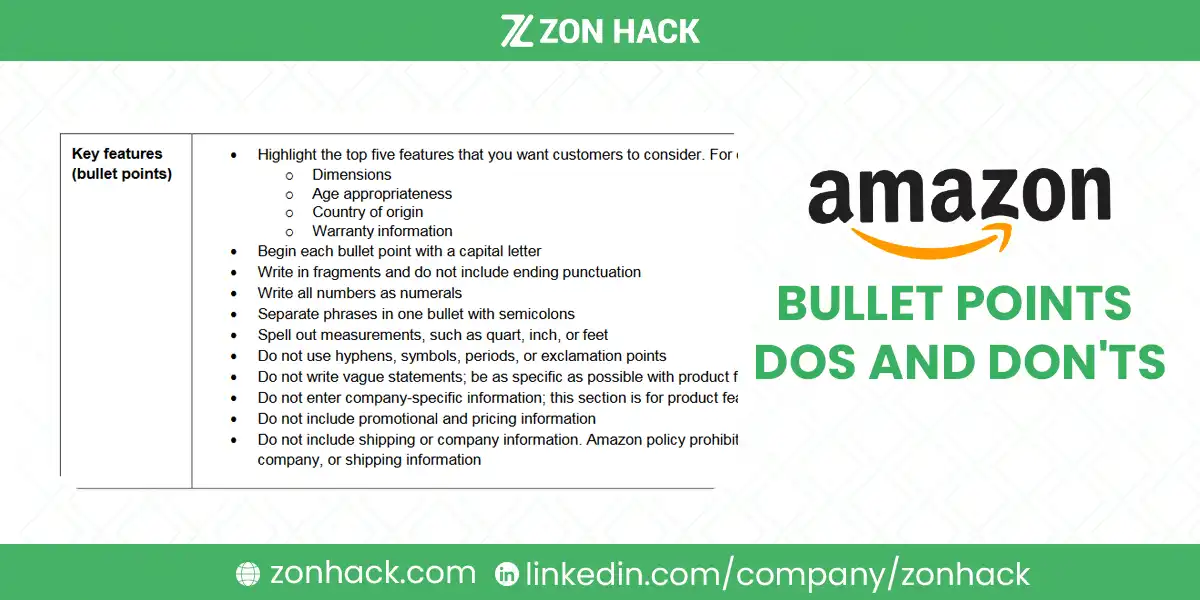Writing bullet points for your Amazon product listing is crucial to your success as a seller. They not only convey essential information to buyers but also play a significant role in improving your product’s visibility on the platform. In this guide, we’ll cover what makes Amazon bullet points effective, explore common mistakes, and discuss advanced strategies to boost your sales.
The best Amazon bullet points are concise, benefit-focused, SEO-optimized, and structured to address customer pain points. Avoid information overload, stay clear of vague claims, and ensure clarity to increase both customer engagement and product visibility.
What Are Amazon Bullet Points and Why Are They Important?
Amazon bullet points are concise sentences that highlight a product’s most important features and benefits. These appear near the top of a product listing, typically under the product title, and help potential buyers quickly assess if the product meets their needs.
Amazon’s bullet points are critical because they:
- Provide key information buyers need to make a purchase decision.
- Improve your listing’s SEO by incorporating relevant keywords.
- Influence conversion rates by engaging customers with compelling, benefit-driven content.
In essence, well-crafted bullet points are the difference between a shopper scrolling past your listing and a shopper clicking “Add to Cart.”
What Makes a Good Amazon Bullet Point?
The effectiveness of your bullet points depends on how well they communicate the product’s value. When crafting bullet points, there are several best practices to follow:
Conciseness is Key
Each bullet point should be short and to the point, ideally between 15–20 words. Brevity ensures that customers can quickly understand the product’s benefits, especially on mobile devices, where many buyers browse Amazon.
Focus on Benefits, Not Features
While listing features (e.g., “Made from stainless steel”), always pivot to explain the benefits (e.g., “Ensures durability and rust resistance for long-lasting use”). This approach connects the product to the customer’s needs, making it more compelling.
Clarity and Simplicity
Use straightforward language and avoid technical jargon that may confuse potential buyers. The clearer the bullet point, the easier it is for the reader to digest.
Quantifiable Information
Where possible, use numbers or specific details to build credibility. For example, “Lasts up to 12 hours on a single charge” or “Supports up to 300 lbs” provides customers with concrete expectations.
How Can Bullet Points Improve Your Amazon SEO?
Amazon’s search algorithm (A9) considers keywords used in bullet points. Proper keyword integration boosts your product’s ranking on relevant search results, increasing visibility. Here’s how you can optimize your bullet points for SEO:
- Strategic Keyword Placement: Use relevant keywords naturally within each bullet point. Focus on integrating 1-2 keywords per point, ensuring they feel like a natural part of the description.
- Use Long-Tail Keywords: Incorporate long-tail keywords (e.g., “best wireless headphones for running”) to capture more specific search queries. These help attract more targeted buyers.
- Avoid Keyword Stuffing: While it’s important to include keywords, overstuffing them can hurt readability and deter customers. Amazon may even penalize your listing, so balance is essential.
What Common Mistakes Should You Avoid in Amazon Bullet Points?
Even experienced sellers make mistakes that can weaken their listings. Here’s a breakdown of common errors to watch out for:
Avoid Information Overload
Cramming too much information into each bullet point is a surefire way to confuse potential buyers. Stick to one clear key benefit per bullet to maintain clarity and focus.
Steer Clear of Vague Language
Statements like “high quality” or “best on the market” lack specifics and don’t convince buyers. Instead, focus on concrete attributes that set your product apart.
Don’t Exaggerate Claims
Making unrealistic claims (e.g., “Best in the world”) can damage customer trust and result in negative reviews. Stick to factual information and highlight genuine strengths.
Watch for Grammatical Errors
Proofread your bullet points for grammatical mistakes and typos. Sloppy writing detracts from your product’s professionalism and could hurt your conversion rate.
How Can You Make Bullet Points That Drive Sales?
Creating compelling bullet points involves more than just avoiding mistakes. Here are advanced strategies to help you stand out from the competition:
- Start with the Most Important Information: The first bullet point should highlight the most compelling benefit or feature of your product. Research shows that the first point receives the most attention, so make it count.
- Leverage Emotional Appeal: Appeal to customers’ emotions by weaving in storytelling or addressing pain points directly. For example, instead of just saying, “Durable design,” you could write, “Built to withstand years of heavy use, so you never have to worry about it breaking.”
- Include Customer Testimonials: You can integrate snippets of positive customer feedback (e.g., “Loved by 95% of our customers”) to boost social proof and build trust with potential buyers.
- A/B Testing: Optimize your bullet points by conducting A/B tests. Use two different sets of bullet points and track which version converts better. This process helps you fine-tune the messaging over time.
Table Example:
Let’s break down the difference between an average bullet point and an optimized one:
| Feature | Average Bullet Point | Optimized Bullet Point |
| Durability | High-quality material. | Crafted from stainless steel, providing years of rust-free durability. |
| Battery Life | Long-lasting battery. | Lasts up to 12 hours on a single charge, perfect for all-day use. |
| Weight Capacity | Strong and sturdy. | Supports up to 300 lbs, ensuring safety and reliability. |
How Do You Align Bullet Points with Other Product Listing Elements?
To maximize your listing’s impact, it’s essential to create synergy between your bullet points, product title, and images. Here’s how:
Coherence with Product Title
Your bullet points should complement the product title, reinforcing key benefits mentioned earlier. For instance, if your title mentions “wireless,” emphasize how your product’s wireless capabilities benefit the customer in the bullet points.
Use Product Images for Reinforcement
Ensure your product images align with bullet points by visually showcasing the benefits you’re describing. For example, if you mention a “lightweight, portable design,” include a picture that demonstrates portability.
Update Regularly
Product listings should evolve based on customer feedback and new trends. Review your bullet points periodically to ensure they remain relevant and up to date.
FAQs About Amazon Bullet Points
1. How many bullet points should I use in my listing?
Amazon allows up to five bullet points per listing. Use all five, ensuring each addresses a unique benefit or feature.
2. Can I use HTML formatting in my bullet points?
No, Amazon does not permit HTML formatting in bullet points. However, you can use simple formatting like capital letters for emphasis.
3. What is the character limit for Amazon bullet points?
Amazon recommends keeping bullet points under 1,000 characters, but concise points of around 150-200 characters tend to perform best.
Summary
To summarize, well-crafted Amazon bullet points can significantly boost your product’s visibility and sales. By keeping them concise, benefit-driven, and SEO-optimized, you’ll engage potential buyers and increase conversions. Avoid common pitfalls such as information overload, vague language, and exaggerated claims. Instead, focus on highlighting customer benefits, using quantifiable data, and appealing to emotions to connect with your audience.
If you regularly refine your bullet points based on performance data and feedback, your listing will continue to improve, offering higher conversion rates and better rankings on Amazon.
For sellers looking to maximize their product listings, every detail counts—especially your bullet points.




